Design and style
I thought that before getting into the subject, it is worth clarifying the difference between "design" and "style", because in this article I am going to talk about both terms and I consider that they are not exactly the same. The word "design" should be used to refer to the architecture, concept, forms, and materials that define an object, with the main objective of fulfilling one or more functions. It should be noted that -contrary to what many people think- aesthetics is not the primary objective of design, although a well-designed object tends to be beautiful.
As far as "style" is concerned, I understand that it is the discipline that aims to make objects beautiful. Thus, we have very well designed objects, which perfectly fulfill their function, while saving resources, but they are not particularly stylish, and other objects with a lot of style, but in reality, they are not well designed, because either they do not fulfill their function perfectly, or they need an excessive use of materials or labor for their manufacture.
I would say that there is a general tendency to confuse both terms, and it is common to hear about "design", when in fact what we are referring to is "style". In my opinion, styling should be part of good design, and good design should be coherent and honest with the function and philosophy of the object.
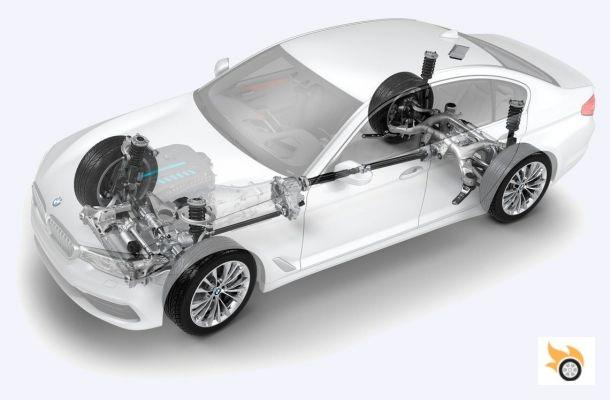
The design and styling of internal combustion cars
Cars and their architecture have been evolving for more than a century. Design and style have adapted to the technical requirements of internal combustion cars: grilles to cool the radiators and mechanics, proportions and volumes that adapt to the engines, platforms conditioned by exhaust lines and transmissions, space for the fuel tank, interiors conceived to house the gear lever and clutch pedal...
Thus, our subconscious has become accustomed to front ends with air intakes (which we unconsciously associate with a mouth), air vents, exhaust outlets, long bonnets suggesting power, etc. Of course, designers and stylists know this, and cars are designed to appeal to our subconscious, which after all, is the one that decides whether we like a car or not, and ultimately decides the purchase.
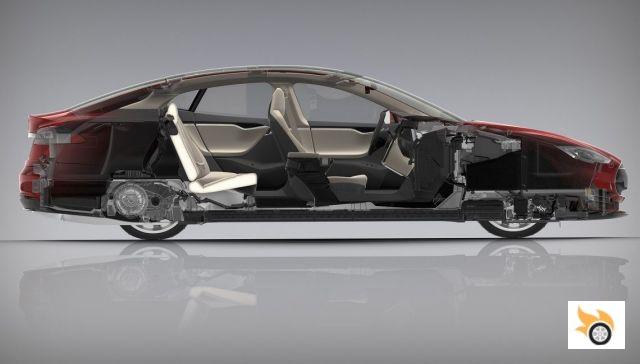
The design of electric cars
Currently there are few models with a specific electric architecture, and there are important conceptual differences between them. Engineers are working flat out trying to find the best solutions to the problems posed by this new technology, which they approach from different philosophies... That is, it is not yet clear which architecture will prevail, but what does seem is that electric cars will need less space for the engine and peripherals, and a priori, more space for the batteries, which also weigh their own.
The truth is that it is not clear if the motors will end up in the rear, in the front, in both, or if they will be in the wheels... and this will affect the position of the trunk (or trunks). Either way, it seems that electric cars will be able to make better use of longitudinal space, so they will either be shorter, or more habitable (if they keep the length). The front end may be shorter and steeper, without compromising safety in the event of a head-on collision, and the batteries are likely to be under the floor, which helps to achieve a good balance between the two powertrains, as well as a very low centre of gravity, although it could make the cars a little taller overall.
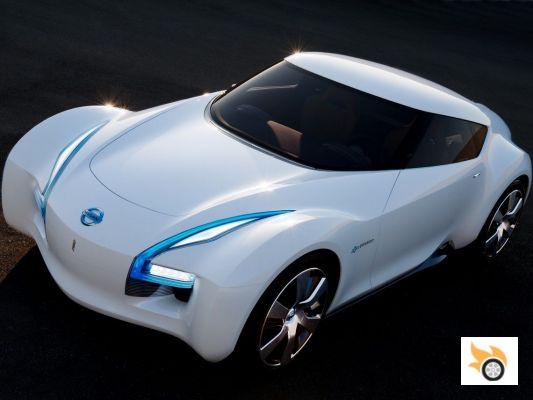
The styling of electric cars
As I said above, styling is really important, as it makes the difference between liking a car and not liking it. On the other hand, we like things we are used to... and here appears one of the first aesthetic problems of electric cars, because as they need much less cooling than cars with thermal engine, the front grille could be much smaller, or even disappear... As I said, we are used to relatively large air intakes, and very often, with shapes reminiscent of a mouth, so a car without a grille, or with a very small grille seems strange to us. It's like a face without a mouth.
That's why Tesla designed a kind of black front "mouth" for its Model S, a "mouth" that was actually almost completely closed by a kind of black shield, and now that Tesla seems to think we're getting used to it, it has replaced it in the restyling with a three-dimensional shape that -although- still pretends to recall the shapes of a common air intake. Otherwise, the design of the Model S is relatively conservative, there must be a reason for that...
Other brands -which didn't have so much at stake- have been more daring, and have designed their electric cars in such a way as to attract attention. We could say that the general idea is to adopt an unaggressive and relatively futuristic style, with relaxed shapes. Why?
Well, first of all they have to appeal to the potential customer, and this type of customer either has ecological concerns, or is attracted by technology and futuristic designs, or all at the same time. On the other hand, and as I have my doubts about the profitability for the brands of the first electric cars, I think the brands approach it more as an investment in the future and brand image. So it seems logical that brands want their electric cars to attract attention, serving as rolling technological advertisements. As far as design languages and proportions of the different models and concept cars are concerned, there are some common points (blue details, aerodynamic shapes, not very aggressive lines... ) but also some divergences between the different production cars or prototypes that I would like to analyze in detail, would you join me?
Nissan Leaf
Launched in 2010, the Leaf was intended to stand out from the rest of the Nissan range of the time with a futuristic design and not at all aggressive. It was to reach the ecological and citizen customer, without aspirations velocísticas, and that should like to drive a car with a somewhat naive design. That's why it barely has a front air intake, and its shapes are all sweet curves and futuristic forms, which transport the driver to a greener and more human world... It can't be said that it has much style, nor that it's a good design (its shapes are somewhat gratuitous) but it achieves the objectives of transmitting the content and distinguishing itself from the rest of the traffic.
Tesla Model S
Aside from its five-door coupe silhouette, with an unusually low and relatively short nose (that's the thing about its quirky architecture), there's little about the Model S that shows its innovative architecture. It could be said that the Tesla's styling is quite conservative, perhaps inconsistent with its technological content, but you have to understand that Tesla was already taking enough risks when it decided to launch the Model S to get creative with a groundbreaking style, which could pull back some customers...
It seems a logical choice, because in addition, Tesla does not need - like other brands - to differentiate their electric cars from the rest of a range with thermal engines. A curious detail is the false front grille, which began as black and smooth (in an obvious attempt to present a design that was not too shocking) to virtually disappear in the recent restyling, once Tesla has decided that its Model S can afford a slightly more futuristic look.
Renault ZOE
I must admit that I love the ZOE, with that sharp, yet rounded front end, which conveys movement, but not aggressiveness, with its friendly yet elegant proportions, and nice design language. Perhaps it would have been a good idea to design it in a way that more clearly expresses its status as an electric car. I imagine that Renault was afraid that this would detract customers with conservative tastes, I think that the brand has missed the opportunity to make a bigger impact as an electric manufacturer. I hope the likely next generation will keep the ZOE's pleasing lines, but add a shape that better expresses its content.
BMW i3
BMW has made a tremendous technological effort with the i3 and i8, designing a specific and very sophisticated lightweight carbon platform, intended to partly compensate for the weight of the batteries... and of course, I wanted the exterior design and styling to reflect that, with a very technological, futuristic and original design. The goal has been more than fulfilled, and the i3 is a rolling ad, besides having an image that will appeal to potential customers, who will value its design that conveys a certain quality, originality, modernity, and technology.
Mercedes-Benz Generation EQ Concept
Mercedes says it will launch a whole range of models under the EQ brand: from the large SUV to the convertible two-seater, and this time it seems that the world's oldest brand is serious. That's why the design of this EQ Concept needs to be analysed carefully. It's certainly not revolutionary, and nothing in the EQ Concept's proportions suggests its electric technology - in fact, its prominent front volume seems unnecessarily large - heralding a very conservative design concept, which will surely carry over to the production models.
Nor have the Stuttgart designers dared to dispense with the typical grille of the brand, unnecessary in an electric car, designing a simplistic virtual screen, which only makes sense from an ornamental point of view, and reminiscent of the "sticker" grilles of some NASCAR cars ... but the last straw is the "ornament" of the lower rear bumper area that is intended to remind some exhaust outlets ... Otherwise, the usual blue colors of electric cars, and little else ...
However, we must recognize that the design is nice and suggests aerodynamics, and I imagine that this conservatism in the design must have been very meditated by the members of the board of directors.
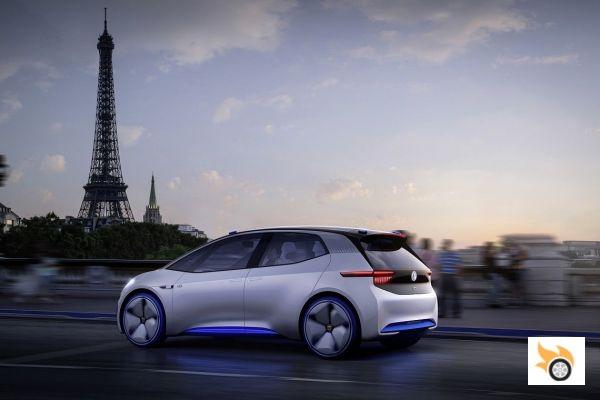
Volkswagen I.D. Concept
Perhaps the most interesting electric concept car from a design point of view is the recent VW I.D., because in addition to foreshadowing the electric brother of the Golf, it boasts a very coherent and even imaginative design for what the German brand is used to. The proportions are very interesting, and its silhouette with a very short hood is consistent with the architecture, which does not need a previous volume that houses the engine.
As far as the design language is concerned, I think it's an interesting evolution of the one started with the brilliant Up! The dynamism is achieved by playing with the volumes, which integrate the wheels into the overall design, and with the ribbing that surrounds the car and perfectly delimits the waistline, with attractive, steeply raked side windows. The surfaces gracefully combine curves with sharp edges, and there is not a hint of aggressiveness, no unnecessary nerves of character. Overall, the rather minimalist design suggests the economy of materials that eco-friendly customers appreciate.
Once again, the stylists have had to "do something" to the front of the car, as our subconscious - accustomed to grilles on the front bumper - would reject a monochrome front bumper, and they have designed a curious silver-coloured stippling. A solution that contributes to the car's friendly appearance, and although it is reminiscent of a grille design, it does make it clear that this is a very special car, a vehicle that doesn't waste energy by generating too much heat. Good thinking.
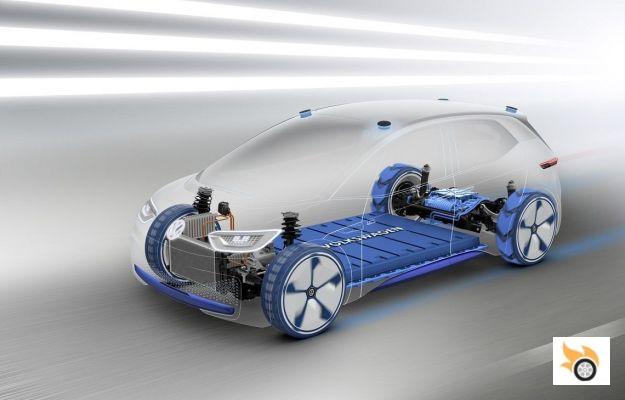
Will this be the design of the cars of the future?
It is significant that while the design of "normal" cars is becoming increasingly aggressive and with ventilation openings that suggest tremendous energy losses - in the form of heat - we see that electric concept cars are moving in the opposite direction, with simple shapes that suggest economy of resources, friendliness, aerodynamics, lightness and cleanliness, something perfectly logical. On the other hand, the simplicity of its design also suggests the reliability of simple things?
Maybe I'm wrong, but maybe in a few years the clean and friendly aesthetics of electric cars will prevail, and the remaining combustion cars will tend to imitate them, disguising their condition of excited and overheated dinosaurs.

























